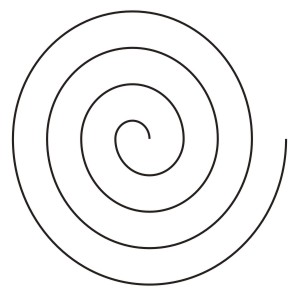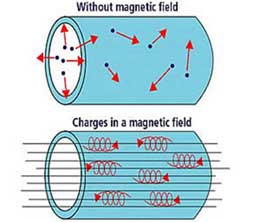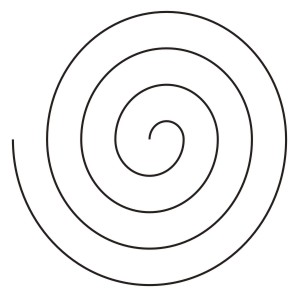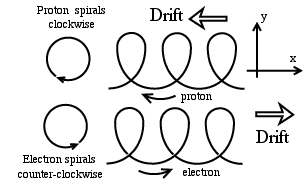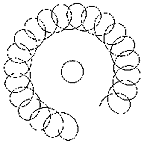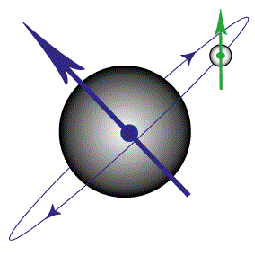
| AIR
Spiral Symbol of Air
Magnet Field and Electrical Charges In a magnetic field, any moving particles are forced to spiral along the magnetic field lines, because they are charged. So, if you create a circular magnetic field, then plasma particles will be trapped, perpetually circulating around the loop.
Electron's Spiral In a magnetic field, any moving particles are forced to spiral along the magnetic field lines, because they are charged. So, if you create a circular magnetic field, then plasma particles will be trapped, perpetually circulating around the loop.
If an electron’s motion closely parallels the magnetic lines of force it will still be deflected somewhat by the magnetic field, but now it will be forced into a spiral that follows the magnetic lines of force out of the magrid, and around one of the coil cross-sections. Electrons that spiral along the magnetic lines of force out of the magrid and back in again, are said to be circulating.
If the electron and the proton (or other positive ion) were free,
they would simply move in those directions. But they are not free,
because of the magnetic force.
Electrons Spiral Counter Clockwise
Protons Spiral Clockwise Why electric fields parallel to magnetic field lines are rare in space : 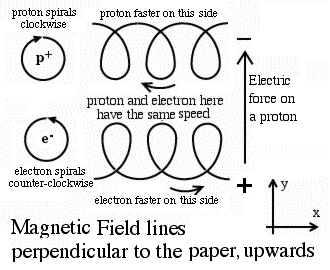 It will be assumed in what follows that the direction of the electric force ("direction of the electric field") is always perpendicular to the local direction of magnetic field lines. Particle drifts in electric + magnetic fields
There exists a reason. In space, ions and electrons spiral around their guiding magnetic field lines, but at the same time they can also slide along those lines, like beads threaded on a wire.
If the electric force had some part in that direction (a "vector
component"), those ions and electrons, as they advance along
their guiding field lines, would also be accelerated by it, and
gain speed. However gaining speed also means gaining energy. Because
energy in nature is conserved, whatever the particle gains, weakens
the accelerating part of the electric field, and unless fresh energy
is constantly supplied, that part does not last long.
There energy is being supplied and the electric force does have a component in the same direction as the magnetic field line.
The Electric Force :
The local magnetic field lines in the drawing (repeated here for convenience) are assumed to be perpendicular to the paper, coming out towards you. Suppose also the electric field representing the electric force is in the plane of the drawing, towards the top of the figure. A straight arrow was drawn giving that direction, which we choose to be the y direction in a system of (x, y) axes, drawn in the bottom right corner.
A positive particle such as a proton, marked here p+ is pushed by the electric force towards the top of the drawing, in the +y direction.
A negative electron, marked e-, is pushed towards the bottom, in the -y direction You can imagine a positive charge and a negative charge somewhere above it, creating that force repelling or attracting the proton or electron.
The
Magnetic Force Alone :
Electric and Magnetic Forces together :
The electric force modifies the motion. Protons are accelerated in the +y direction, so they move a bit faster on the part of their circle.
Electrons are accelerated in the -y direction, so their speed is
a bit greater on the part of their circle closer to the bottom.
Magnetic Drifts :
Electric
currents without any voltage :
As before both ions and electrons circle around magnetic field lines. However, the size of the circle also depends on the strength of the magnetic force the stronger the force, the smaller the radius of the circle. (In the limit where the magnetic force drops to zero, the particles move in straight lines same as circles of infinite radius).
Because the way the strength of the force changes, the orbits, again, are no longer circles but flat spirals, curving more sharply at the top of their motion.
The result as before, is again a crab like sideways "drift." This time, however, protons and electrons drift in opposite directions. Protons move to the left, electrons to the right, and both motions contribute a right-to-left electric current.
All field lines point upwards and the strength of the magnetic field increases inwards, towards the Earth. The drift is therefore in the 3rd perpendicular direction, which carries the particles around Earth electrons counter clockwise, protons clockwise, and the current flows clockwise too.
|
